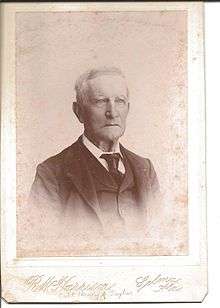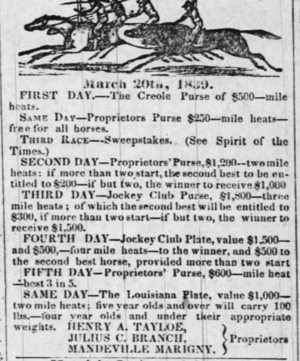Henry Augustine Tayloe
| Henry Augustine Tayloe | |
|---|---|
 Henry Augustine Tayloe I, son of John Tayloe III | |
| Born |
April 8, 1808 The Octagon House, Washington, DC, built by John Tayloe III |
| Died |
July 15, 1903 (aged 95) Prairieville, Alabama |
| Nationality | American |
| Occupation | Planter |
Henry Augustine Tayloe (April 8, 1808 – July 15, 1903) was an American planter, horse breeder and land speculator during the 19th century. He founded the Fair Grounds Race Course in 1939 with Bernard de Marigny, pioneered cotton planting in the Canebrake (region of Alabama) and built St. Andrew's Episcopal Church. He was the youngest son of John Tayloe III and served as his brother's agents in the Canebrake (region of Alabama) later founding Faunsdale, Alabama.
Birth, schooling and career
Tayloe was born on April 8, 1808 at The Octagon House, the city residence built by his father John Tayloe III, who inherited the grand colonial estate Mount Airy, Richmond County, Virginia, built by his father Colonel John Tayloe II, the two of whom were respectively each arguably the wealthiest plantation owners in the country for their generations. His maternal grandfather was Benjamin Ogle, ninth Governor of Maryland, and great-grandfather was former Provincial governor, Samuel Ogle.[1]
The youth called on the Secretary of War, John C. Calhoun, to apply for appointment to a cadetship at the Government Military School, West Point. The Secretary advised the applicant to leave the appointment open to a boy who needed Government aid in his education; he being a son of a rich father. Thereupon he entered the University of Virginia. While he resided in the University a rebellion of the students broke out, in the latter years of Mr. Jefferson's life. He came to meet the students to address them, weeping in his sincere sorrow at the event.
Mr. Tayloe began life as-a farmer in Maryland. There he followed the example of his father, so distinguished in the high pleasure of horse racing. His stable sometimes encountered those of President Jackson. The President always addressed him as "Henry" because of the bond between them of love of the race horse. He would ride his own horse for the race and his method of riding greatly pleased the President. The President nevertheless was bitter against the politics of his father, a Hamiltonian, John Tayloe III.[2]
Mr. Tayloe lived with his parents at The Octagon House and on his farm until 1834, when he came to the Canebrake (region of Alabama) to reside as the agent of his four brothers, investors in plantations and to invest also on his own account. He brought many negroes from the Virginia and Maryland farms. He bought a number of plantations, Oakland near Uniontown, "Woodville" it was then, Faunsdale Plantation, Walnut Grove, Windsor and perhaps others. Windsor was for his brother, Benjamin Ogle Tayloe who lived in Washington. After the payments had been completed, it proved the titles were defective and the sum had to be repaid. At Walnut Grove he built a frame residence of eight rooms, one of the first homes of so pretentious forms in that country. In all that time, he remained a bachelor. He at once brought racers from the Virginia and Maryland stables of his brothers and his own. A mile track was laid off near Prairieville for training uses. His horses were entered at the Greensboro track, at Livingston, at Montgomery, at Columbus, Ga., Mobile and New Orleans. His brother William Henry Tayloe, heir to Mount Airy, Richmond County, Virginia, sent fourteen racers to him at one consignment, all by wagon road, among them was "Robin Hood," brother of the great Boston (horse). From his stable went to the Metairie course, New Orleans, the renowned "Black Maria." There she entered one of four upon a four-mile heat race. Black Maria and two others had each won one heat of four miles. One of the three winners of the heat must win the fourth heat to claim the stake. Black Maria won the deciding fourth heat, the same afternoon, making sixteen miles. She won the sixteenth mile in 2:08 minutes. On Mr. Tayloe's table was habitually used rich silver plate, as long as he lived, won by his mare "Zelina" on the Metairie course. He became bankrupt. His brothers restored his fortune. He lived in comfort on his plantation, "New Hope," past his ninetieth year.
He married Miss Jemison and was the father of four daughters, all married, and a son of distinction in the Alabama judiciary and otherwise. For many years Mr. Tayloe was Secretary of the Alabama Diocesan Episcopal Convention. He was appointed to canvass the State to build up a Bishop's Fund. With energy, he succeeded. By his final report he presented an expense account of $69.70 in full.[3]
Family
Mr. and Mrs. Tayloe were the parents of four daughters Miss Anne married R. L. Maupin who was a distinguished Confederate soldier, the Adjutant General of the Missouri Brigade, later Probate Judge of Marengo County; Miss Virginia who married of New Orleans; Miss Narcissa who married a son of Alfred Hatch Place at Arcola, already named. The youngest daughter married Mr. Shivers of Marion, Perry County. The son, once Chancellor of Alabama, William H -.[4]
Fair Grounds Race Course

Henry A Tayloe founded the "Louisiana Race Course," now the Fair Grounds Race Course, with Julius C Branch and Bernard de Marigny. Tayloe's father, John Tayloe III was a leading turfman, founder of the Washington (DC) Jockey Club (1798); who imported the notable English Thoroughbred Diomed who sired Sir Archy-whose progeny include Lexington, Secretariat and American Pharoah; grandson of John Tayloe II who imported Childers (by Flying Childers), Jenny Cameron and Jolly Rogers (three of the most important colonial imports) and who built the grand colonial estate and stud farm Mount Airy) and organized the first races for March 20, 1839, and lasted for five days. "The First Day was the "Creole Purse" for $500, one mile heats; the same day the "Proprietors Purse" for $250, one mile heats; and third race "Sweepstakes" (See Spirit of Times). Second Day-"Proprietors Purse" $1,200—two mile heat; if more than two start the second best to be entitled to $200-but if two, the winner to receive $1,000. Third Day-"Jockey Club Purse" $1,800—three mile heats; of which the second best will be entitled to $300, if more than two start-if but two, the winner to receive $1500. Fourth Day-"Jockey Club Plate" value $1,500 and $500, -four mile heats-to the winner, and $500 to the second best horse, provided more than two start. Fifth Day-"Proprietors Purse" $600—mile heat-best 3 in 5; Same Day-"The Louisiana Plate" value $1,000—two mile heats; five year olds and over will carry 100lbs.- four year olds and under their appropriate weight." [5]
St. Andrew's Episcopal Church
St. Andrew's Episcopal Church, in Prairieville, Alabama, is a small Carpenter Gothic-style church built in 1853 by the slaves of Henry Augustine Tayloe of Gallion, Alabama, who served as Secretary of the Alabama Diocesan Episcopal Convention. He was appointed to canvass the State to build up a Bishop's Fund. The exterior of the church features wooden buttresses. It appears to have been built from a design in the book Rural Architecture by architect Richard Upjohn.
References
- ↑ Warfield, The Founders of Anne Arundel And Howard Counties, Maryland, 1905, p. 248–250.
- ↑ JW Dubose, "Chronicles of the Canebrake," Alabama Quarterly, Winter 1947 p.522
- ↑ JW Dubose, "Chronicles of the Canebrake," Alabama Quarterly, Winter 1947 p.523
- ↑ JW Dubose, "Chronicles of the Canebrake," Alabama Quarterly, Winter 1947 p.524
- ↑ Times Picayune, March 14, 1839, Page 1
